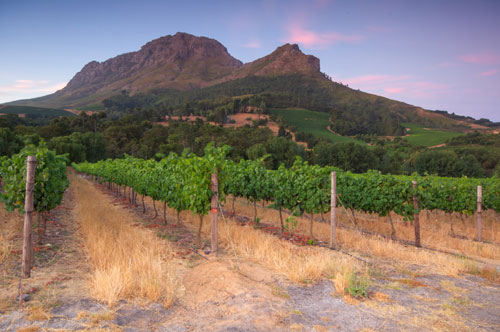South Africa

South Africa is located at the tip of the African continent with most wine regions located near the coastal influences of the Atlantic and Indian Oceans. These regions have mostly a Mediterranean climate that is marked by intense sunlight and dry heat. Winters tend to be cold and wet with potential snowfall at higher elevations. The threat of springtime frost is rare with most wine regions seeing a warm growing season between November and April. The majority of annual precipitation occurs in the winter months and ranges from 250 millimetres (9.84 in) in the semi-desert like region of Klein Karoo to 1,500 millimetres (59.06 in) near the Worcester Mountains.[2] Regions closer to the coast or in the rain shadow of inland mountain chains like the Drakenstein, Hottentots Holland and Langeberg will have more rain than areas further in land. In many South African wine regions irrigation is essential to viticulture. The Benguela current from Antarctica brings cool air off the south Atlantic coast that allows the mean temperatures of the area to be lower than regions of comparable latitude. A strong wind current, known as the Cape Doctor, brings gale force winds to the wine regions along the Cape which has the positive benefit of limiting the risk of various mildew and fungal grape disease as well as tempering humidity but can also damage grape vines that are not protected.
During the harvest months of February and March, the average daily temperatures in many South African wine regions is 23 °C (73 °F) with spikes up to 40 °C (104 °F) not uncommon in the warm inland river valleys around the Breede, Olifants and Orange Rivers. On the Winkler scale the majority of South African wine regions would be classified as Region III locations with heat summation and degree days similar to the California wine region of Oakville in Napa Valley. Warmer regions such as Klein Karoo and Douglas fall into Region IV (similar to Tuscany) and Region V (similar to Perth in Western Australia) respectively. New plantings are focus on cooler climate sites in Elgin and Walker Bay regions as characterised as Region II with temperatures closer to the Burgundy and Piedmont.
The wine regions of South Africa are spread out over the Western and Northern Cape regions, covering 500 kilometres (310 mi) west to east and 680 kilometres (420 mi) north-south. Within this wide expanse is a vast range of macroclimate and vineyard soil types influenced by the unique geography of the area which includes several inland mountain chains and valleys. Within the Stellenbosch region alone, there are more than 50 unique soil types. In general, the soils of South Africa tend to retain moisture and drain well, having a significant proportion of clay (often at least 25% of the composition) with low pH levels around 4. The pH levels of the soils are often adjusted with lime and calcium treatment. Other soil types found in South Africa includes granite and sandstone in Constantia, shale in Elgin and arenaceous shale in Walker Bay.[2] Near the river valleys, the soils are particularly lime rich with high proportion of sand and shale.
See Growing Areas Breede River Valley
See Suppliers Musto South Africa
Credit Wikipedia